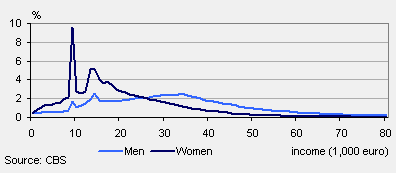Gender income gap has not narrowed in recent years

Female incomes are considerably lower than male incomes. On average, women received 56 percent of what men earned in 2007, the same as in 2003. The gender income gap has not narrowed in recent years.
Incomes of women

Income differences stable
The average male income was nearly 37 thousand euro in 2007, the average female income was more than 20 thousand euro. The income gap between men and women has not narrowed relative to 2003. Prior to 2003, the gap was indeed closing, partly because the female participation rate on the labour market went up, while the male participation rate declined marginally.
Incomes of women by socio-economic category, 2007*

Smallest income differences in the group of non-actives
Women earn less than men, partly because proportionally, many women work part-time. Women’s wages are also lower than men’s. As women have lower incomes, their income-based benefits are also lower.
Income disparities are smaller among benefit recipients than among people who are active on the labour market. Social security benefits are not related to the job(s) a person has had in the past, but to the type of household they belong to.
Many recipients of social security benefits are single mothers. Single mothers receive higher benefits than childless singles. As a result, incomes of female recipients of social security benefits are on average marginally higher than incomes of male recipients.
Income distribution by gender, 2007*

Many women live on low incomes
There are also large discrepancies between both genders with respect to income distribution. Women more often than men are forced to live on low incomes. The group of women living on an annual income of 9 thousand euro is relatively large. These are chiefly married women, whose only source of income is their old age pension.
The highest female incomes vary around 17 thousand euro. These are predominantly women living on social security.
Income distribution of men to a lesser extent revolve around certain incomes and higher incomes are more commonly found in the male population.
Marion van den Brakel and Wim Bos